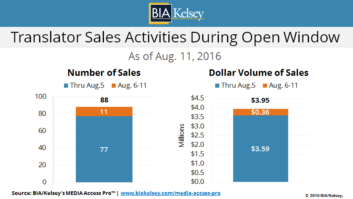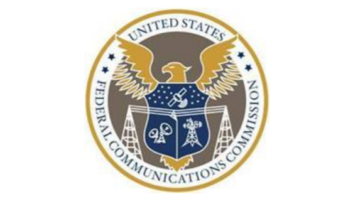As part of the FCC’s Revitalization of the AM Radio Service efforts, the FCC directed its Media Bureau to “…open two FM translator modification application windows for AM stations to modify and/or relocate FM translator stations.” This allows an AM broadcaster an opportunity to acquire and relocate one authorized non-reserved band (92.1 MHz–107.9 MHz) FM translator station up to 250 miles.
The “First Modification Window,” for Class C and D AM stations, is from January 29, 2016 to 11:59 EDT July 28, 2016. The “Second Modification Window,” for all AM stations, begins July 29, 2016 and ends at 5:59 PM EDT October 31, 2016. The FCC Public Notice DA 1491 describing the process and scope can be read at: https://apps.fcc.gov/edocs_public/attachmatch/DA-15-1491A1.pdf
Cris Alexander writes about his experiences preparing his station’s applications for the First Modification Window, which readers may find useful for their preparation.
This year marks my 41st year in this business, and until this January, I had never had any direct dealings with translators. That might seem a little strange, but the fact is that neither the opportunity nor the need existed until then.
As a result, I had to get up to speed fast. The FCC released its order announcing the AM translator windows late in 2015, and because of the way they had set up the translator filing “windows,” they were actually more like derbies – first come, first processed. That meant the race was on, with a January 29 window opening that really amounted to a deadline.
I had for decades been doing allocations work for commercial, full-power FM, so I am no stranger to the principles of contour protection that we use for translators. I quickly learned, however, that there are a lot of ins, outs, policies and somewhat obscure rules that are very familiar to engineers who do translator work, but of which I had little or no knowledge.
DIFFERENT ALLOCATION RULES
For example, in full-power FM work, contour overlap must be considered in both directions – interfering contours of both proposed and protected stations cannot overlap protected contours of protected and proposed stations. In the translator world, because there is no “protected” contour of a translator, overlap of what would be the protected contour by an interfering contour is not considered.
Translators are, however, protected from other translators. If I want to put a translator near a licensed translator, a translator CP or application on file on the same or an adjacent channel, the “protected” contour very much comes into play just as it would with a full-power FM.
And then there are second-/third-adjacent protections. Under the translator rules, if there is no population within the +40 dB overlap area, you can ignore second- and third-adjacent channel protections. (This is also true of other translator overlap situations, but it mostly comes into play in second-/third-adjacent situations.)
Quite often, the +40 dB interfering signal value won’t reach the ground, and since it’s highly unlikely that anyone lives in a point in space up inside that “contour,” that means zero population. The net effect of this rule is that the closer a translator’s site is to a second- or third-adjacent channel station’s site, the better. Someone once told me the best place for a second-adjacent translator is collocated with the other station. I didn’t understand that then, but now I get it.

Fig. 1: Yagi antennas such as this Scala HDCA-5H are
commonly used for translators.
To further confuse things (in a good way), 10.6/10.8 MHz IF short spacings can be ignored if the proposed ERP of the translator is “less than 100 watts.” That’s why you find so many 99-watt translators.
Working in the Canadian and Mexican border zones, things get really interesting. You’d better have a good copy of the treaties and read them carefully before you start trying to site a translator in one of these areas. There are different rules for each country that must be complied with.
Translator antennas are a whole new world. There are many more options than we are used to in the full-power FM realm. In addition to run-of-the-mill single- and multi-bay dipole arrays, you can use yagis (as in Fig. 1), log periodics, and phased/offset arrays of multiple yagis and log periodics. The 15 dB maximum-to-minimum ratio and 2 dB/10 degree rules do not apply.
The FCC database contains many “stock” antenna patterns that you can use and specify the rotation that fits your situation, or you can “roll your own” and key in a custom composite pattern.
You can pretty much do what you want with regard to antennas in the translator world, but there is one caveat: The antenna is specified on the station license, so you can’t simply replace one with another, even with a non-directional antenna, without further FCC authorization, as you can in the full-power FM world. You have to file a modification application and get a CP first. Based on what I’ve seen out there, I’m certain a lot of licensees don’t observe this requirement.

Fig. 2: Many translators operate from shared sites such as this one on
Denver’s Lookout Mountain. Can you spot all the translator antennas?
OUT IN THE REAL WORLD
Once I got a stack of construction permits (CPs) and started working on actually building the translators out, I learned a lot more. In a lot of ways, translator installations are much simpler than full-power station installations, but there are site considerations and rules that must be taken into account.
Many translators will be located at a shared site, and if the shared site is home to other FM translators or full-power stations, some filtering will almost certainly be required to prevent IM products from being generated and transmitted. Fig. 2 shows a potpourri of translator antennas on Denver’s Lookout Mountain. A lot of translator power amplifiers are broadband for frequency agility, and this makes filtering all that much more important. Better check with the manufacturer to find out what kind of rejection is needed to keep from producing and transmitting unwanted signals.

Fig. 3: Filters are often required at multi-user translator sites,
especially if there are full-power FM stations at the site or nearby.
This filter provides 70 dB of rejection at 1.6 MHz to take care of a
100 kW station on one side and a 100-watt translator on the other.
The “newcomer doctrine” is a longstanding FCC policy that says the newcomer to a site is responsible for fixing all the interference issues that arise as a result of the newcomer’s operation. That means that you may have to buy filters for some of the other site users as well as for your own transmitter. It’s definitely something to pay attention to, especially if your antenna will be in close proximity to another station’s antenna. Many site lease agreements also contain a requirement as such. Fig. 3 is an example of a filter isolating a high power FM from a low power translator.
Of course, getting to the people responsible for operating and maintaining other translators at a shared site can be a challenge in itself. The FCC rules require that a posted sign, like one in Fig. 4, to be mounted on the antenna support structure. The sign identifies the translator and provides the name, address and phone number of the licensee or local representative. That rule is not always followed, and even when it is, signs can fade or be blown off the tower. The landlord or site manager may be the best source of contact information on other site users.

Fig. 4. FCC rules require signage identifying the
translator and providing local contact information.
In my travels of late, I have seen all kinds of “funny business” with translator installations, such as directional antennas going the wrong way and unlicensed antennas. While in most cases this kind of thing won’t significantly impact other site users, sometimes it can. The FCC’s database and online FM Query search tool is an excellent way to pull up information on other licensees, including copies of their licenses or other authorizations. It doesn’t take long to figure out what antenna, ERP, height and location a translator station is supposed to have.
PIRATES!
One other thing I have learned is that open frequencies are a breeding ground for pirate stations. Naturally, pirates and even legitimate Part 15 broadcasters want a clear frequency, and if there is an unused channel in a community, that’s where they’ll be. It’s a good idea to begin listening to a frequency weeks before putting a new translator on the air to make sure that there aren’t other signals there, authorized or otherwise, that will cause interference.
As I was preparing to put a new translator on the air on an empty channel in Denver, I started listening to the channel and heard a very strong signal airing a very eclectic music mix complete with time and temperature announcements. The signal was listenable for miles in any direction, suggesting something other than Part 15 power. We DFed the signal to a house in a neighborhood and could clearly see the ten-foot vertical whip antenna in the back yard.
Some neighbors saw me walking up and down the sidewalk in front of the house with a spectrum analyzer and yagi antenna pointed at the house. I called the local FCC office and they sent an agent out the next day. He confirmed the pirate’s location, but by then, undoubtedly alerted by neighbors, the operator had powered down to Part 15 limits. I sent a politely-worded letter to the resident advising him that a licensed translator would soon be coming on the air on the frequency he was using and I asked him to find another spot. A couple of days later the signal went away and hasn’t come back.
A couple of weeks after that we began getting reports of a strong pirate signal on our frequency up near Boulder – we knew it was a pirate signal because a voice identified the station as “Pirate Radio!” We DFed that one to a one square mile area in the densely populated hilly neighborhoods on the west side of Boulder and handed it off to the FCC. As of this writing we are still waiting on remedial action.
Translators and boosters can be a wonderful means of providing a quality 24-hour signal for an AM station or filling in coverage gaps caused by terrain shielding. They broadcast a signal just like full-power stations, but the arena in which they operate is completely different. It pays to become familiar with Subpart L of Part 74 of the FCC rules and spend some time with folks that are very familiar with translator installation, operation and maintenance. You’ll be up to speed in no time.
W.C. “Cris” Alexander is director of engineering at Crawford Broadcasting Co. and a longtime Radio World contributor. He is an SBE Fellow and past recipient of the Robert W. Flanders SBE Engineer of the Year award.












